A lens through which to view and contemplate
as we act and participate in the collective awakening in our communities
By Thay Phap Dung
Dear Fellow Practitioners on the Path,
In these past six months, our human family throughout the world has met monumental challenges and suffering, for many of us the most drastic in our lifetimes. Today we all have a role to play in the rising tide of collective awakening to racial injustice and systemic inequalities. Together we continue to face the climate and ecological crisis, the virus crisis, and a societal crisis in terms of poverty, class inequality, and the imbalance of power and militarization of our world. It is abundantly clear how all these elements are interconnected consequences of the fundamental human crisis, the spiritual crisis. We practice remembering this shared suffering as a human family caused by our unskillful, toxic, exploitative, and discriminative ways of living across many centuries.
Today we reach out to our spiritual community to invite us to stop, look deeply and broadly, and seize this wonderful and painful moment to dig down honestly into our practice—100 percent, as Thay would say. Where are we with our practice: How are we doing? Are we calm or furious? Are we afraid or invigorated? Are we lonely or sad? Are we engaged or do we want to look the other way? Or are we all of these things? As we honor our emotional experience at this moment and care for what is arising in us, we are invited to examine our lives and our community and help move our world towards a more inclusive and compassionate society.
How can we help, respond to, and participate in this moment of potentiality? We are reminded of our Teacher during the war in Vietnam when the bombing and killing seemed unlikely to end. In his most dire moments, Thay had to pause and hold his face with his two hands to grieve and to keep himself from exploding out of anger. He wrote many poems about the pure love of his childhood to keep his loneliness warm; and he translated Buddhist texts to nourish himself and keep his Bodhicitta alive. He did not only rest there in his inner refuge of the Ultimate Dimension, but used it as the foundation for his rigorous and charged actions to affect the historical events of his time. Thus, there was the continual emergence of our tradition of Engaged Buddhism, of contemplative actions for a healthy, compassionate, and awakened society.
We would like to take this chance to offer some points of departure for reflection, as we explore what we, as practitioners and Sanghas, can contribute. They are not a kind of definitive guidance, but an invitation to come together and look deeply and help our Sangha be a more inclusive, harmonious, and awakened place of refuge for all.
Mindfulness Trainings as a Compass: The Five and the Fourteen
The Mindfulness Trainings are our guide and our teacher. They are the gems in our pocket. In difficult moments, we can turn to them for inspiration and direction. They are a precious and deep inheritance from many generations of teachers, and a concrete expression of our love for ourselves, others, and the planet. We need to regularly show up to recite them together and have discussions about how they apply to our current situation, to collectively check our direction and practice. Reciting the Mindfulness Trainings and looking deeply together will help us identify the right action for ourselves and our community. Mindfulness practice and meditation must go hand in hand with contemplation, a deep-looking into the aspects of our daily lives and social structures to examine their ethical and moral foundation, which can help move us into compassionate and direct action. The Mindfulness Trainings can act as a mirror to examine ourselves and our community to see where new branches can grow and which roots need to go deeper.
Grounding Ourselves in the Energy of Mindfulness, Individually and Collectively
This is a moment to cultivate deep, attentive listening to what is going on within us and around us. It is a time to hear what is being said, and what is also being left unsaid. We must trust in our intuitive insight based on our practice of mindfulness and concentration and not be carried away by the emotions and dispersion of the collective. Stillness and clarity of mind are crucial as we move to mindful action. Our mindfulness sustains our clarity. And when we are clear, we are courageous: we know what to do and not do, we know what needs to be said and not said, and we never veer from the path of compassion. We need to take many moments throughout the day to check in with our body and mind. How is suffering manifesting in our body right now? How can we take care of it and calm it? Can we discern its collective and individual aspects, its base for manifestation? Can we allow ourselves to be kind? Mindfulness is a source of peace, healing, and transformation. Once we have the capacity to be there, listen to, and care for our suffering, it’s time to offer this capacity to listen to the suffering of others.
Lotus in a Sea of Fire
When Thay was confronted with the devastation of war, he took refuge in the insight of eleventh century Vietnamese Zen Master Ngo An, who reminds us that:
The jade burned on the mountain retains its natural color,
The lotus, blooming in the furnace, does not lose its freshness.
We aspire to be the bright jade and the lotus, which retain their essence and deepest values when tested in the fire of adversity. The mind of love remains intact. We aspire not to lose sight of anyone’s humanity and to be aware not to water seeds of vengeance, fanaticism, or self-righteousness. Whatever that jade or lotus is for us, that deep innate knowing or gut feeling, we are determined not to lose our mind of love and compassion, no matter what temptation burns within our furnace.
Action and Non-action
The question is not whether we act or don’t act, but how we act—both as individuals and as a collective—from the quality of our being. Thay once said, “Sometimes you don’t do anything, but you do a lot. And sometimes you do a lot, but you don’t do anything; it doesn’t help.” Our actions should be genuine expressions of our love, care, and awakening. With our insight and the “eye of signlessness,” we can maintain the spirit of true action of “non-action,” doing what needs to be done with freedom and peace, without grasping for an outcome. We act from a place of being, of stillness, of peace. As Thay has said, “The means and the end are one. You cannot remove the means from the end, and you cannot remove the end from the means. Our way of being has to be the peace we are working for.”
It is helpful to examine our actions using these lenses from our Order of Interbeing tradition: skillfulness, appropriateness, timeliness, openness (non-attachment to views), and to base our actions on our real insight and experiences. Without these elements, even dharmic actions with good intentions, can be toxic and cause harm and more suffering. Whether our practice is the practice of action or non-action, if we don’t include these considerations, we risk going against the true path.
Steadfast Non-Dualism is Non-Violence and Compassion
As we engage, challenge, and demand change, justice, and collective awakening, we must be diligent in maintaining a non-dualistic view and approach, whatever the circumstances and whomever the “perpetrators” we think we are contending. There is a need to transform and remedy the systems, symbols, and structures of injustice and to engage in constructive dialogue with those who harbor ignorance and hate in their hearts in support of such systems. It is also essential to initiate and implement, beyond just talk, the necessary corrective legislation to bring systemic change. There is a moment in time where discernment is needed as well as clarity, courage, and compassion to call out what is acceptable and what is no longer tolerable, and demand transformation. But as practitioners, we are encouraged to be vigilant about not being the tempted fish and biting the bait of dualism; and resist the divisive hook “that if you are not with us, then you are one of them, or you are against us.” We must maintain our heart of compassion and non-discrimination—even in the torrent of our radical actions, even at the risk of feeling excluded from this historic moment. Who is our enemy, and where is their home? As trailblazers on the awakened path, we shall be careful not to be fooled by the signs of outer appearances and achievements or to let others be the masters and governors of our fate.
At this moment, to stand up and speak out for racial justice and against racism is essential, just as it is for gender, class, and climate justice. We must also have the courage, patience, and openness of mind to look deeply into the root causes of social injustice, and listen deeply to those who are suffering, learning how we are each contributing, individually and collectively. At the same time, let us not be too quick to make hostile assumptions about those who, for whatever reason, are silent or less vocal about making proclamations.
Building and Nourishing Community
We recognize that our sanghas are primarily a place of spiritual refuge: a place where we all, regardless of our background, identity, and life experience, can find a home in our shared mindfulness practices—for our healing, transformation, and awakening. We have our physical body, and we also have a Sangha body, and both need nourishment to thrive. We must continue to engage with our local Sangha and community: to actively invest in our regular program of practice, and in our relationships, to deepen our mutual understanding, and offer each other spiritual and practical support. These are all ways of taking action.
Creating authentic harmony, togetherness, inclusiveness, and awareness in our diverse Sangha may take time. That time is an investment in our spiritual growth, and it is an offering to the world. Does our Sangha nourish us? Are we happy enough in the Sangha and can care for our suffering? Are we leaving anyone out? Are we truly a refuge for ourselves and others? Together, we are determined to be the living proof right in the here and now in this trying moment, that a future of diversity, respect, love, and friendship is possible.
We are also a community of resistance, responding not just to an external force or oppressive system, but also to inner forces of reactivity or complacency. The action of some contains within it the nonaction of others; everyone is contributing to a multi-faceted resistance in their own way and according to their capacity. Each one of us is responsible for examining and questioning our comfort zone. Are we hiding in our practice? Or running away in our action? Whatever our capacity for engagement, we all belong to what Thay called, in Fragrant Palm Leaves, “a community of truth-seekers and reformers throughout time and space.” Whether our Sangha is ebbing or thriving in the face of challenges, we have to cherish and sustain above all our brotherhood and sisterhood—our spiritual friendship and solidarity.
The Long Haul
Taking actions that nourish ourselves and our relationships is essential. Our connection and love for one another will sustain and nourish our collective awakening for decades to come. Thay taught us in Plum Village that while we do our work and engage with the world, we must always remember to make time to sit together, walk together, drink tea together, share a meal, and enjoy music together and not to forget and take for granted our companions on the path. As our teacher reminds us in his poem, Butterflies over the Golden Mustard Fields, “the work of rebuilding may take thousands of lifetimes, but it has also already been completed just that long ago. The wheel is turning, carrying us along. Hold my hand, dear ones, and you will see clearly that we have been together for thousands of lifetimes.” How long must we wait? Have we put forward our best actions?
Not Losing Ourselves
How can we include care for ourselves, our loved ones, and our mindfulness practice in our way of engaging and in all our actions of body, speech, and mind? It is possible to organize interventions that embody our values of compassion, nonviolence, peace, solidarity, and inclusiveness. While participating in social action, we must also be attentive to maintaining our sovereignty at every moment. How can our practices help and support our Sangha to sustain itself in its engagement for the healing and transformation of society? Do we feel pressed for time? Have we neglected the simple tiny moments of joy in our day that once nourished us but now seem to be in our way—the yellow dandelions in the front yard, the warm rays of the sun on our face, or the lullaby swing of our hammock? Whatever those jeweled moments were for us, do they all seem to be a luxury now, no longer part of our “important” agenda? When our actions are motivated by limitless love and freedom born from our deep-looking and understanding, we won’t be overtaken by anger, and we won’t lose ourselves and burn out.
Imagine a New Paradigm
We leave you with this message from our teacher written during Vietnam’s burning struggle against the oppression from within and without. We invite us all to remember that we are all part of a lineage of “truth seekers and reformers” and to find the time to allow their presence to imbue every cell of our body and mind and be the heart-force that energizes all our actions:
“When we discover something to be true today through our own direct experience, we will see that our previous assumptions were wrong, or at least incomplete. Our new way of looking transcends yesterday’s desire, prejudices, narrow-mindedness, and habits. We see that to use the golden molds and emerald yardsticks of yesterday’s understanding are nothing less than slavery or imprisonment. It is impossible to accept things we know to be false when we attain a new understanding of reality. Our actions will be based on our understanding. We will follow only those rules we have tested through our direct experience. We will discard the false rules and conventions of the current social order. But we have to expect that society will turn on us with a vengeance. Human history is filled with the tragedies caused by that vengeance. History teaches that we die if we oppose the system. Yet, many individuals continue to challenge the darkness, despite the danger in doing so. Those who pursue the truth are members of the community of truth-seekers and reformers throughout time and space. They do not resign themselves to a collective fate that offers no laurels.”
—Thich Nhat Hanh, Fragrant Palm Leaves
Let us be participants in this collective awakening in whatever way that we are called upon, based on our insight and direct experiences. As our social, political, and economic order unravels and is tested, let us come together as the rattan twines of the forest, to be stronger as a community so that we will have the courage and support to uproot the discrimination, violence, and injustice in our society and also to embrace those who may hold differing points of views and experiences.
May we all nourish trust and respect in our beloved community, knowing that each one of us will find our way to contribute, and that even the tiniest acts of kindness, unnoticed and humble, will not be lost and forgotten by the wise ones of old.
We have built a precious community, nurtured by our teacher’s love and wisdom, and his presence “in the West” from the eighties onward. The Order of Interbeing community, the monastic Sangha of monks and nuns, urban and rural Sanghas throughout the world, the Dharma Teachers Sangha of Elders, the Wake Up Sanghas, the Sanghas for the Black, Indigenous, People of Color practitioners, the Sanghas for Mother Earth, and many other affinity Sanghas—all part of the community of truth-seekers and reformers. Of course, there needs to be more work for outreach and inclusivity in many of our Sanghas. Let us hold each others’ hands while we humbly do our best to affect the “rules and conventions of the current social order.”
Some Concrete Actions and Reflections
- Be informed, learn, listen, reflect. Identify what parts of our Sanghas have been doing inclusivity, diversity, and outreach work. What are some successes and challenges?
- What actions?
- Identify within ourselves the places, notions, and habits where we can be more open. Reach for refuge and reflections from our Dharma siblings. What concrete changes can we make?
- Look into our Sangha and how we may have ignored the hidden discriminations and biases, but also to discriminate the deeper dharmic substance from the superficial and not be fooled by the outer forms, appearances, names, positions, and constructions.
- Seek out opportunities in our surrounding communities for outreach programs to share the practice, resources, etc.
- Establish a steady program to support attendance from the Black, Indigenous, people of color, and under-represented groups at our practice centers and our retreats, including online activities.
- Create more opportunities for presence and expression from the under-represented parts of our community.
- This is an open list. Please contribute your ideas and reflections in the comments below.
With trust and love,
Thay Phap Dung
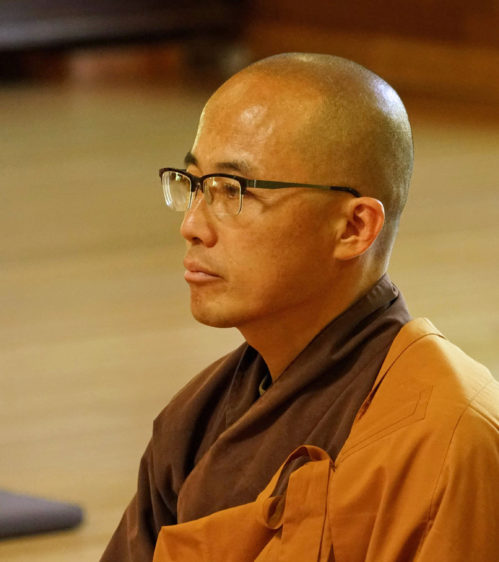
Brother Chân Pháp Dung (Dharma Embrace) was ordained on February 4th 1998 at Plum Village France. He received the Lamp Transmission from Thich Nhat Hanh and became a Dharma Teacher in 2004, serving as abbot of Deer Park Monastery in California from 2001 to 2010.
Resources:
From Thay and the Plum Village Mahasangha:
- The Five Mindfulness Trainings
- The Fourteen Mindfulness Trainings
- Larry Ward’s Dharma Talks
- ARISE Sangha
- Earth Holder Community: Embodying Racial and Ecological Justice in the Face of the Climate Emergency. An 8-week Online Retreat, September 13-November 7, 2020
- Thay on How to stay calm in the storm (short clip)
- Creating True Peace: Ending Violence in Yourself, Your Family, Your Community, and the World (concrete practices for deep listening, loving speech, reconciliation and peace-building in communities and nations)
- Together We Are One: Honoring our diversity, celebrating our connection (teachings from Thay’s retreats for people of color)
- The Art of Communicating, Thich Nhat Hanh
- America’s Racial Karma: An Invitation to Heal (forthcoming book by Dharma teacher Larry Ward)
Wider resources for study and reading:
- White Awake: Study, Support & Action: Cultivating Resilient Allies in Struggle
- SF Sangha Sit. Walk, Listen. Because Black lives Matter
- “How to Fight Without Hating: Lessons in Power and Love” By Valerie Brown
- “Freedom and Energy from Healing Our White Racism” By John Bell
- Awakening Together: The Spiritual Practice of Inclusivity and Community by Larry Yang
- Healing Resistance: A Radically Different Response to Harm by Kazu Haga
- Trauma-Sensitive Mindfulness by David A. Treleavan, PhD
- Biased: Uncovering the Hidden Prejudice that Shapes What we See, Think, and Do by Jennifer L. Eberhardt, PhD
- White Fragility by Robin DiAngelo, PhD


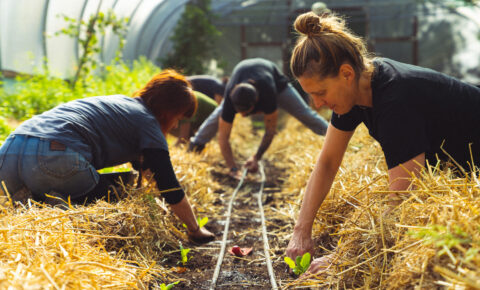
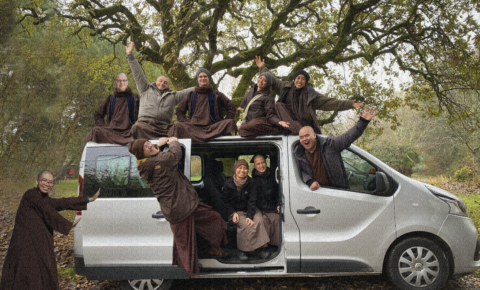
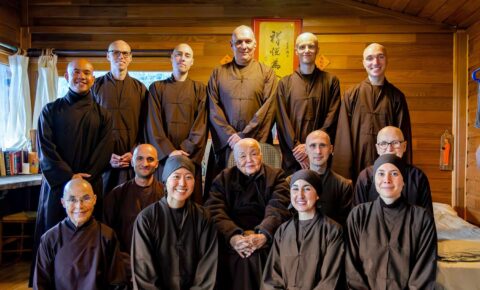
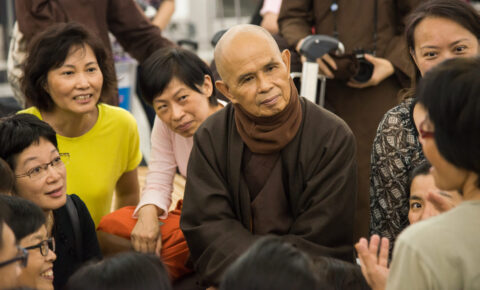
Join the conversation